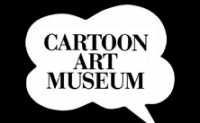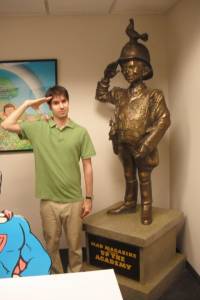
January 3, 2011
 CR Holiday Interview #13—Andrew Farago
CR Holiday Interview #13—Andrew Farago


*****
I think I would hire
Andrew Farago for any job out there -- roughly equivalent to
his current position at the
Cartoon Art Museum or far removed, you name it -- based solely on what it was like to interview him for this series. It was so easy, the answers came back in such a full, furious state, that I nearly forgot that I interviewed him. He's that San Francisco institution's curator/gallery manager, and describes his duties below. The success of comics enterprises rises and falls on the skill and dedication of key employees like Farago, and in a day where jobs in comics are scarce I wanted to interview him about his. Farago's also a comics writer, a cartoonist and fine writer
about comics and cartooning. His latest,
The Looney Tunes Treasury is one of those perfect gift-item style books for a specific kind of fan, of which Farago is one -- but the prose has enough clarity I had no problem devouring and enjoying the volume.
It's worth noting that as we're publishing this back and forth the Cartoon Art Museum
is starting its yearly fundraising efforts. I encourage everyone to visit and consider giving.
Farago lives in Berkeley with his wife, the cartoonist and writer
Shaenon Garrity. I had fun interviewing him, at least as far as I can remember. -- Tom Spurgeon
*****
 TOM SPURGEON: Andrew, one of the underlying themes of this year's series is jobs, and you have one of the more interesting jobs in comics. What's an average day -- or a better-than-average day -- like for you at the Museum? Are there ways that it feels very much like a job and ways that it maybe doesn't?
TOM SPURGEON: Andrew, one of the underlying themes of this year's series is jobs, and you have one of the more interesting jobs in comics. What's an average day -- or a better-than-average day -- like for you at the Museum? Are there ways that it feels very much like a job and ways that it maybe doesn't?
ANDREW FARAGO: I've been with the Cartoon Art Museum for ten years now, including a little over a year as a volunteer, and for the most part, it's my dream job. On an average day, I've got about a half-hour commute into San Francisco from my home in Berkeley, and I'll spend the day on some combination of correspondence, managing the museum's archives, planning upcoming exhibitions anywhere from three months to three years in advance, public relations, planning events, programming and classes, and dealing with anything unexpected that crops up throughout the day.
Roughly ten weeks out of each year are spent installing new exhibitions, which generally includes matting and framing artwork, writing gallery text, painting the walls, and planning the design and layout of each show. When I'm curating an exhibition, the selection of artwork usually takes place a month or two before our opening date, and a big part of the job is writing, calling and wheedling artists and collectors into sending their work to us on time. We've actually had artists bail out less than two months before an exhibition is scheduled to start, so we've had a few exhibitions that I've had to pull together in just a couple of weeks, and it's my job to make sure that nothing
looks like it was assembled in just a couple of weeks.

I'm very fortunate in that I often find myself in situations where I can't believe that I'm getting paid for this. Joining the National Cartoonists Society and meeting about 90 percent of the strip cartoonists I grew up reading in a social context has been incredibly cool. It changes your perspective when you flip through the comics section and realize that you've got good drinking stories about half the artists on the page. I've had dinner with
Gahan Wilson, walked around Rockefeller Center with
Larry Hama (which would have made 12-year-old me's head explode), toured the offices of
Mad Magazine,
Marvel Comics and
DC Comics, shingled a roof with
Jeff Keane, given museum tours to
Art Spiegelman and
Mo Willems, had tea with
Hayao Miyazaki, and went to a
Simpsons script read-through in Los Angeles earlier this month thanks to
Tom Gammill, whom I met through the
NCS. I've honestly given up on ever making a wish list of comic/cartoon things I'd like to do, because I've gotten to do so many amazing things as a result of this job. If I'm hanging out in a pub with
Alan Moore and Scooby-Doo next year, I don't think I'll be all that surprised.
On the downside, when you're working for a non-profit that you really believe in, it's easy to find yourself working 50 or more hours a week, tackling extra projects on weekends, and never quite being off-duty. And there's a lot of paperwork, fundraising and grant writing, which balances out the more exciting aspects of the job. My family are the only non-cartoonists in my address book, so I feel like I'm on the clock even when I'm hanging out with friends.
SPURGEON: To build from there a bit, how have you guys done in the current economy? I think of you as a group about which comics may sometimes forget a bit, but I also think of you as one of the better, more established groups. What's the state of the museum?
FARAGO: The state of the museum, almost always, is "hanging in there." We're always fundraising, we're always writing grants, we're always on a tight budget, but somehow we've managed to survive for more than 25 years.
The past three years have been especially tough, with fewer and fewer grants available and less and less money available from those sources, less disposable income in our patrons' pockets, and the loss of our Executive Director,
Rod Gilchrist, to cancer in early 2009. There's never a great time to be an arts-related non-profit, and there's been a lot of belt-tightening in that sector in recent years.
Oddly enough, I think we've weathered the bad economy better than a lot of other non-profits and museums because we're so used to running everything on a tight budget with the bare minimum number of full-time staff. Our current Executive Director,
Summerlea Kashar, has been with the museum longer than I have, and she and the board of directors are the reason that we're talking about the museum in the present tense.
We're in the midst of our big annual fund drive right now, and that accounts for a pretty major portion of our yearly operating budget. We're looking for
straight-up cash donations, people becoming
Cartoon Art Museum members, and get involved in other ways, such as volunteering, donating artwork for auctions, sponsoring exhibitions, renting the museum for corporate events or private parties... seriously, just drop me a line and I'll let you know how you can help keep us around for another 25 years. And I'd love to have this job for another 25 years, honestly. Probably longer.
SPURGEON: I got to visit the museum in 2010 for the first time in probably a dozen years, and I had some specific questions about its operation. For one thing, when did you move to ground floor occupancy and -- if it's even something you know -- has that made a difference for the museum? What about the obvious gentrification of the neighborhood surrounding it? The neighborhood was a lot less stabby this time around. Finally, you seem to have what many successful museums have -- a thriving store. Is that the case? How do the store and the events play alongside more traditional fundraising avenues to keep the place afloat?
 FARAGO: We made the move to our current location in late 2001, after the rent at our previous location skyrocketed as a result of the dot-com boom. Everything went into storage for about six months, and there was no guarantee that we were ever going to re-open, but we were really fortunate that the space at 655 Mission opened up when it did. (The Ansel Adams Center for Photography, which occupied the space before we did, wasn't able to sustain operations there after sinking a lot of money into renovations there, so we inherited a very nicely designed museum space.)
FARAGO: We made the move to our current location in late 2001, after the rent at our previous location skyrocketed as a result of the dot-com boom. Everything went into storage for about six months, and there was no guarantee that we were ever going to re-open, but we were really fortunate that the space at 655 Mission opened up when it did. (The Ansel Adams Center for Photography, which occupied the space before we did, wasn't able to sustain operations there after sinking a lot of money into renovations there, so we inherited a very nicely designed museum space.)
The neighborhood, known as the Yerba Buena Arts District, is one of the nicest areas of San Francisco. Old-timers have told me that the whole neighborhood used to be mostly warehouses just a couple of decades ago, but the new San Francisco Museum of Modern Art and the nearby Pac Bell/SBC Global/AT&T Park really changed the landscape. Our immediate neighbors include The Museum of the African Diaspora, SF Camerawork, The GLBT Historical Society, Zeum, The Museum of Craft and Folk Art, The California Historical Society, The Contemporary Jewish Museum and The Yerba Buena Center for the Arts, all of which make it a very easy place to spend the day in San Francisco. About half of these have come in since we moved in, and it's been great to see this neighborhood develop.
The growth of the bookstore over the past few years has been a real team effort. As visitors to the museum prior to 2008 will remember, our initial setup involved subletting the bookstore to Foto-Grafix books, run by Jun Ishimuro, who'd run the store for the building's previous tenants, the Ansel Adams Center for Photography. As a result, the store was a kind of funky combination of high-end photography books, old Cartoon Art Museum exhibition catalogs, some books relating to current exhibitions and whatever cool stuff Jun could find at Last Gasp.
When the Foto-Grafix contract came up for renewal, our late Executive Director, Rod Gilchrist, decided that the museum should take over the store and he and the board of directors drew up a plan, found an experienced bookstore manager, Heather Plunkett, and arranged for our current, 100% cartoons and comics shop that we've got now.
Special events and exhibitions drive sales at the store quite a bit. We get a lot of walk-in traffic, having a really sharp street-level storefront, but like every business right now, you've got to do everything possible to keep customers coming back. With us, it's making sure that we've got at least one or two artists coming in every month, and having a full complement of weekend programs to ensure that we'll have repeat visitors.
In the past two y
posted 12:00 am PST | Permalink
Daily Blog Archives
November 2019
October 2019
September 2019
August 2019
July 2019
Full Archives


